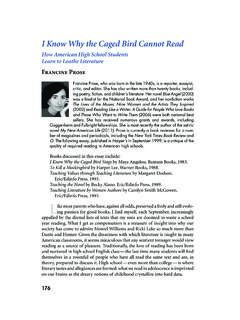Transcription of The CAGED Guitar System - Amazon Web Services
1 1 2012 Video 4 The CAGED Guitar System First of all, let s look at an example below on how to use the CAGED Guitar System : 2 2012 Video 4 The example showed above demonstrates the general idea of how the CAGED System works in a certain chord progression. The big thing about the CAGED System (or any other aspect of Guitar playing) is to be able to visualize different things at different times. In the CAGED System , we are trying to visualize how the different a certain chord progression as close together as possible in a certain location on the fretboard. In the example given above, instead of playing the open C and G chords as well as the 6th string barre chord for F, we are playing all of these three chords in the area around the 5th to the 8th frets. As we are playing all three chords as close as possible to one another, we become more efficient and playing becomes easier.
2 How do we figure out such chords? It is through using the CAGED System that we find the answer. The premise behind the CAGED System is that each major chord is available in five chord shapes ( CAGED ) and that they follow the exact sequence (again, CAGED ) across the fretboard of the Guitar . All other chords ( minor, maj7, dominant 7ths, etc.) are derived from these five basic open chord shapes: Take note at this point that when we refer to CAGED , we refer to the chord shapes ( the way our fingers form over the fretboard) rather than the actual triads (the notes of the chord). We can use these chord shapes to shift up and down the Guitar and play a lot of things from interesting chord voicings to solos. 3 2012 Video 4 The interesting thing about the CAGED System is that it s easy to remember all chord shapes of a particular major chord.
3 Here we have the CAGED sequence for the C major chord: Try playing these shapes in the exact sequence as shown in the chart. Have you noticed something interesting about it? The acronym CAGED follows the sequence of the chord shapes as they should appear on the Guitar fretboard from the lowest fret to the highest and then it repeats itself as you move higher up the fretboard. For example, you played the open C major chord which forms the C shape. You can expect that the next shape that starts at the 3rd fret 5th string is an A shape. Succeeding these are the following chord shapes: a chord shape spanning the range from the 5th to 8th frets (G), 6th string barre chord at the 8th fret (E), and a D shape chord with the root starting at the 10th fret. The sequence actually forms the CAGED acronym in accurate succession.
4 Pretty neat, right? Some shapes, such as the G shape, may be awkward to play as a barre chord. However the point of the CAGED System is for you to be able to visualize the chords on the fretboard and not so much as to be able to play them. This is because the CAGED System mostly serves as your guide to knowing where particular chords are on the fretboard, especially if you are trying to play solos and other things. You don t really have to play all the notes of the particular chord shape at the same time. In terms of playing melodies, the CAGED System provides us with another way of thinking about how to play notes melodically as opposed to the linear kind of thinking that scales provide. 4 2012 Video 4We can also use the CAGED System to play a chord progression using with chord shapes that are close to one another.
5 In this way, we become more efficient players. For example you wanted to play a C-F-G chord progression around the areas between the 5th to 8th fret. For that we play a C major chord that has a G shape, an F in a C shape, and G in a D shape: By knowing our chord shapes through the CAGED System , we can play a chord progression with all chords falling under the same spot. Try playing the first example (the first chart of this topic). You ll notice that we re not playing all of the strings of the chord shapes. This is because we can be selective in terms of what notes to omit and what notes to play. As long as the choices are comfortable and useful, they will work well. Another benefit of learning the CAGED System is that we can at least five different voicings for the same chord.
6 One reason why a guitarist might choose to play a different 5 2012 Video 4chord shape, other than technical concerns, is to add a different kind of timbre to the music. Try this example with the same C-F-G chords in the area between the 5th to 8th frets.









